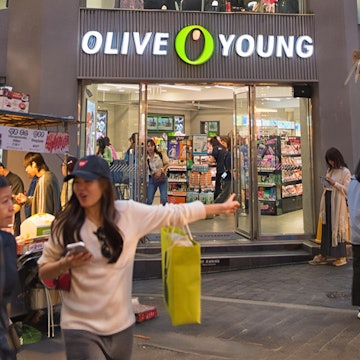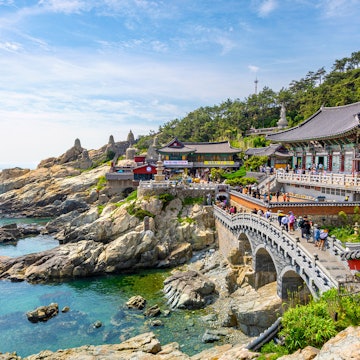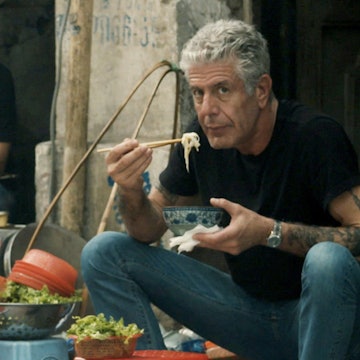
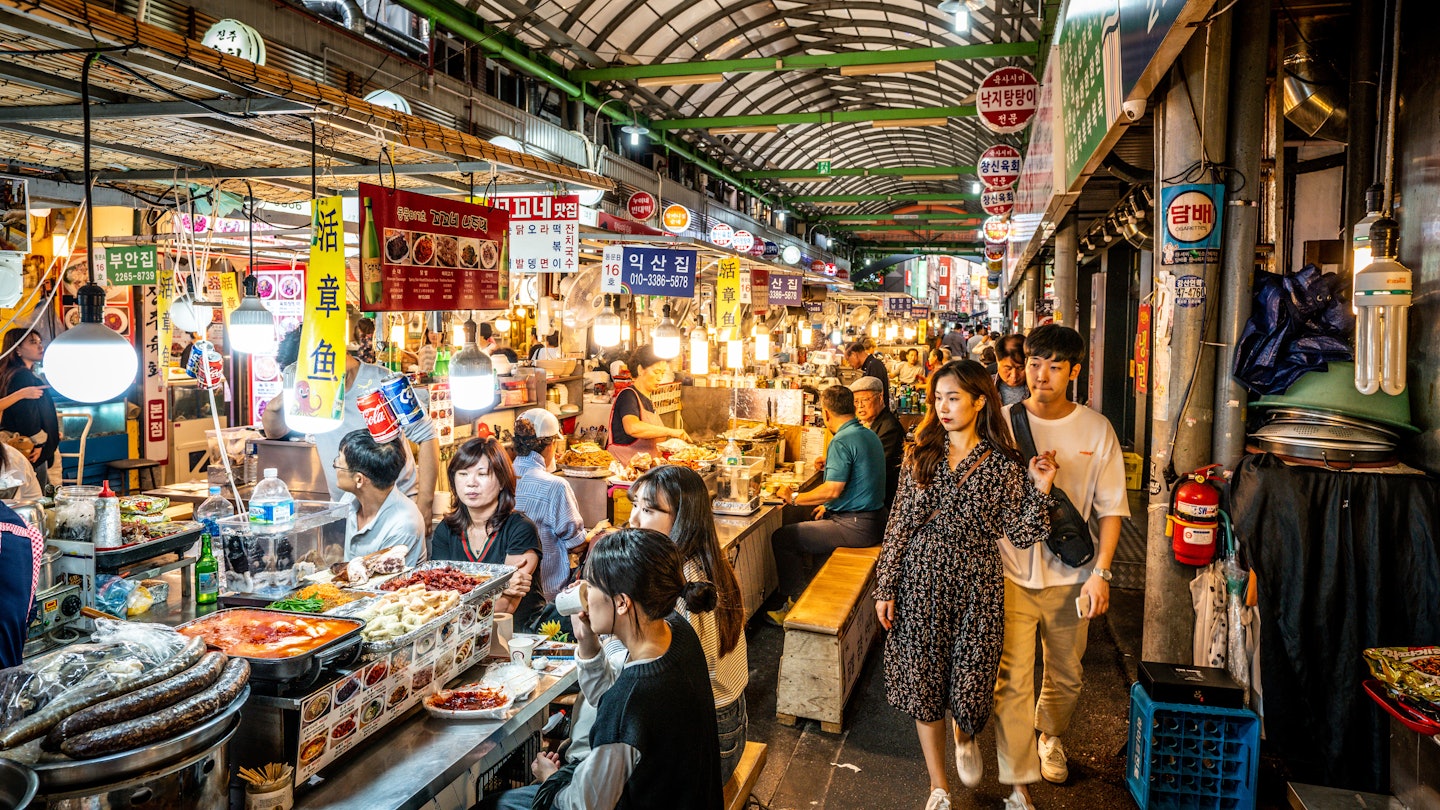
Gwangjang Market. iStock/Getty Images
Ultramodern Seoul has something to offer 24/7, and you'll want to fill every minute of your visit to South Korea's capital. Spending three to five days here will allow you to fully appreciate the city without rushing between its sleek high-rises and the picturesque Bukchon Hanok Village, from Gwanghwamun for the ceremonial changing of guard to the very contemporary DMZ, and across time in a place that can contain both the 14th-century Jogye-sa and the latest K-Pop sensation.
Fill a day or so at the National Museum of Korea, in time-tested palaces and around Seoul's vibrant districts – and a night or two on a late-night food and drink tour. Reset and rejuvenate in a spa or find serenity at a temple. Then escape the urban crowd on a day trip (historic Suwon, roughly an hour away by train, is a popular one), or extend your itinerary for a longer road trip that captures unmissable experiences and tempting food all around this country.
Get on your way with this guide to 20 of the best things to see and do on a visit to Seoul.
1. Taste the street food at Gwangjang Market
Street food in Seoul is beloved for its spice, variety and affordability, and there’s no better place to try it than Gwangjang Market. Dating from the early 20th century, this covered market has gained a reputation for having some of the best Korean cuisine.
Planning tip: Start with an order of tteokbokki (stir-fried rice cakes in a bright orange spicy sauce), followed by a couple of mandu (dumplings) and a pajeon (savory green onion pancake). For dessert, try hotteok (a pancake filled with brown sugar and cinnamon) or bungeoppang (a fish-shaped pastry filled with sweet red bean paste). Then do it all over again.

2. Glory in the historic past at Gyeongbokgung
If you only have time to see one sight in Seoul, make it the splendid architecture, serene pagodas and mazelike grounds of Gyeongbokgung (Palace of Shining Happiness). Originally built in the 14th century during the powerful Joseon dynasty, the palace was destroyed during the 16th-century Imjin Waeran (war with Japan) and rebuilt in the 18th century. Gyeongbokgung is the largest and most elegant of Seoul’s five royal palaces.
Planning tip: Watch the ceremonial changing of the Royal Guard in front of the massive Gwanghwamun before admiring the striking hip-and-gable buildings, tranquil ponds and delicate cherry trees. Wrap up your visit with a stop at the National Folk Museum of Korea, which sits on the palace grounds and features exhibits on traditional Korean culture.
3. Shop for the latest trends in Myeong-dong
You’ll want to break out the credit card for an afternoon of spending in Seoul’s most famous shopping district. Myeong-dong is renowned for trendy fashion labels, deluxe department stores and cosmetic boutiques packed with famed Korean beauty products. Once you’ve sufficiently stocked up on mask sheets and moisturizer at Innisfree and Etude House, check out the Myeong-dong Night Market for street food and quirky souvenirs.
The area is also home to some of Seoul’s cutest cafes, with the Pink Pool Cafe at the Stylenanda Pink Hotel flagship store being the ultimate eye candy. This confectionery-colored spot has an ice-cream-parlor vibe, an indoor ornamental pool and sweet-as-sugar decor, making it a popular place for photo shoots.

4. Stroll along the Cheong-gye-cheon
In the heat of summer, nothing beats a walk along Cheong-gye-cheon (Cheong-gye stream). An oasis that unfurls for nearly 11km (7 miles) through the towers of central Seoul, this waterway is lined with walking paths and trees, and is crossed by bridges. The original stream was covered with an elevated highway after the Korean War, but in 2005, the city undertook an urban renewal project to refresh the area and reintroduce the stream to the landscape. Since then, it’s become a popular spot for locals and tourists looking to cool off or take a leisurely break from the city’s hustle and bustle.
5. Go for a dip in a jjimjilbang
More than just a way to get clean, bathing in Seoul is a full-fledged social activity. Koreans gather at bathhouses (jjimjilbang) with friends and family typically once a week. Jjimjilbang can range from an establishment with just a couple of small dipping pools to massive aquatic palaces with multiple pools, water features, cafes, saunas, relaxation rooms, gyms, spas and arcades.
First-timers should know that bathhouse etiquette requires bathing in the nude, and some bathhouses don’t allow patrons with tattoos. Once you’ve bared all, dip yourself in the hot and cold pools, followed by a stretch in the sauna, then opt for a full-body scrub to emerge baby soft from your bathhouse experience.
Planning tip: The female-only Spa Lei draws patrons for its elegant atmosphere and invigorating massages.

6. Hike in Bukhansan National Park
Bukhansan National Park is listed in Guinness World Records as “the most visited national park per unit area” – which is easy to understand since it’s set within the city limits and easily reachable by public transportation. You’ll often see athletic Koreans in colorful hiking gear riding the subway to this spot on weekends.
The park covers 80 sq km (31 sq miles) of jagged peaks, with hiking trails, dozens of storied temples and 1300 species of plants and animals. The five-hour 7.6km (4.7-mile) round-trip hike to the 836m (2744ft) summit of Bukhansan is well worth it to see Seoul spread out before you in all directions.
7. Sing in a noraebang
Walk down any busy street in the university districts on a Friday or Saturday night and you’re likely to hear distant singing wafting through the air. Chances are it’s not an errant K-Pop band but the raucous merriment of karaoke at a noraebang (singing room). This late-night activity involves private rooms with big-screen TVs, hefty binders of song lists and even disco balls or musical instruments to accompany the sing-along. Top it off with room service bringing snacks and cocktails and it’s a recipe for a great night out.
8. Sip soju and makgeolli
The traditional Korean beverages soju (a vodka) and makgeolli (rice wine) have been respectively distilled and brewed since the 13th century and are the most beloved drinks in this thirsty nation. Soju also has the surprising distinction of being the world’s best-selling spirit, perhaps helped by the fact that a standard bottle often costs less than a bottle of water.
While upmarket small-batch distilleries like Samhae Soju and Hangang Brewery create artisanal varieties, the most common labels, such as Jinro and Seoul Makgeolli, can be happily imbibed at picnic tables on sidewalks outside convenience stores across the city.
Planning tip: Those new to the Korean alcohol scene should check out the Sool Company, which offers tasting tours, brewing classes and special events.
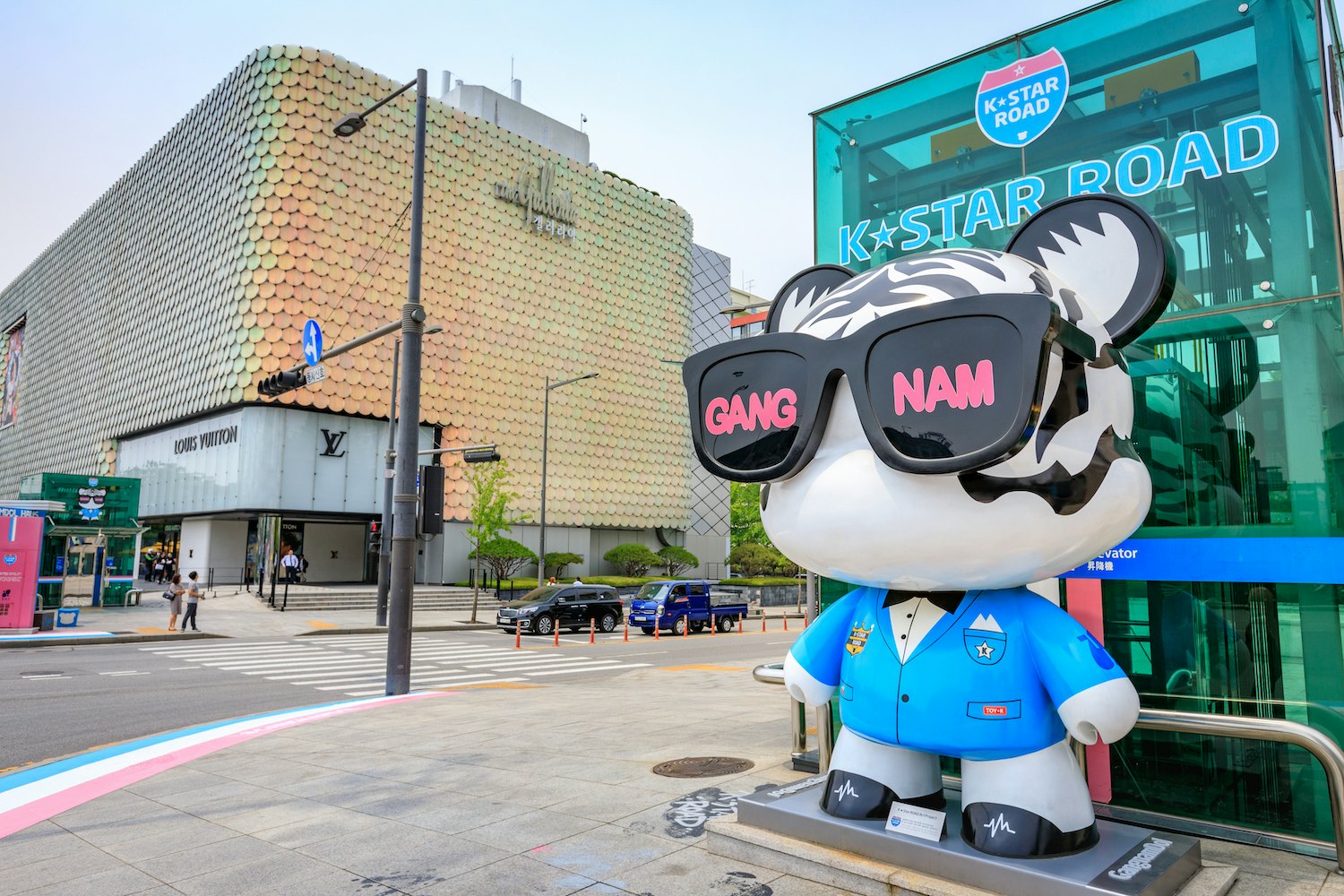
9. Star search on K-Star Road
You’re probably familiar with the Hollywood Walk of Fame, but do you know the Seoul boulevard in glamorous Gangnam dedicated entirely to K-Pop artists? Instead of stars on a sidewalk, K-Star Road has a parade of GangnamDols, 3m-tall (10ft) statues of cartoon bears decorated to represent a different K-Pop singer or band, including Super Junior, Girls’ Generation and BTS.
Planning tip: After taking a few selfies with your favorite bears, pop into GangnamDol Haus near the Apgujeong Rodeo subway station to pick up a few mini bears as souvenirs.
10. Stay at a Buddhist temple and sample life with the monks
The iconic image of a colossal Buddha statue looking over sleek high-rises can be seen at the 8th-century Bongeun-sa. Although most visitors come to snap a photo or two, you can actually participate in temple life with the monks. Over a weekend, join in vegetarian meals, morning chanting, meditation and even the 108 daily prostrations, all meant to clear the mind and bring you closer to achieving inner peace.
Planning tip: Temple-stay programs are offered at various temples throughout Seoul.
11. Spend the night in Bukchon Hanok Village
Graceful sloping roofs, ornate tiles and colorful dancheong (intricate paintwork under the eaves of Korean palaces) come together to create the traditional Korean house, called hanok. Tucked between the Gyeongbokgung and Changdeokgung (Palace of Illustrious Virtue) complexes lies Bukchon Hanok Village, a historic district with hundreds of charming hanok, often used as a backdrop for period movies and shows.
Planning tip: While the village has cafes, teahouses, museums and boutiques, it’s also the site of a handful of hanoks that operate as guesthouses. Guests can sleep on ondol (heated floors), walk through kimchi pot–filled courtyards and generally get a feel for what life was like in old Seoul.

12. Get a bird’s-eye view at N Seoul Tower
N Seoul Tower, a broadcasting structure from 1969, rises 239m (784ft) into the sky from its mountain perch above the city. It still has active transmission antennas, though today it’s better known for an observation deck with 360-degree views of the capital. The top of the tower also has a few dining options, including a swanky rotating restaurant serving French fare.
Planning tip: To reach the tower itself, you can ride the Namsan Cable Car aerial tramway or hike the meandering trails to the top through Namsan Park. For another impressive vantage point, head to the 555m (1820ft) Lotte World Tower for the world's highest observation deck.
13. Take a day trip to the DMZ
A visit to the northern border may well be the most unusual 24 hours you’ll spend on the Korean peninsula. The 250km (160-mile) border between North and South known as the DMZ (Demilitarized Zone) is one of the world’s most closely guarded borders.
Various outfits, such as DMZ Tours, bring curious onlookers from central Seoul to the border area to catch a glimpse into North Korea from Dora Observatory, explore the Third Infiltration Tunnel (originally dug by North Korean soldiers) and even step into North Korea in the Joint Security Area.
14. Visit the K-Pop Square
The K-pop genre of music has taken the world by storm. Bands like BTS, Blackpink and Twice have legions of fans well beyond the Korean peninsula. While attending a favorite artist's show or buying merch may be a nuisance for your budget, there’s a place in Seoul that will make your K-pop-loving heart beat faster and won’t cost you a thing. Located at COEX Mall, the K-Pop Square features a Gangnam Style statue with handprints of many K-pop idols. Also, it hosts a Ktown4u store, where you can lose yourself in a universe of genre-devoted records, merch and events.
Planning tip: While you’re at COEX Mall, don’t miss another superb Seoul attraction, the dazzling Starfield Library.
15. Explore Korean culture at the Seoul Museum of Craft Art
Located off Anguk Station, the Seoul Museum of Craft Art (or SeMoCa) proposes an interactive tour throughout centuries of Korean craft, showcasing more than 20,000 items. This museum with free entry is set in a contemporary building with open, airy white-clad spaces. Even if you’re not into crafts, come for the fantastic rooftop that resembles a rolling hill.

16. Roam through electric Hongdae at night
There’s no need to pay entrance fees at glitzy nightclubs to feel the night beat of Seoul. Just head to Hongdae, the energetic area in the western end of the Korean capital. Walking down Hongdae Street after dusk is an experience in itself. Neon lights pulse and bass pumps out of the numerous bars and discotheques. Being in Hongdae is among the most fun things to do at night in Seoul and a thrilling introduction to the capital’s after-dark scene.
Planning tip: Held every Saturday, Hongdae Free Market is a great for shopping. The market has artwork, jewelry and crafts made by local artists.
17. Feel the creative energy of Seongsu-dong
Working factories rub shoulders with repurposed warehouses that now host hip cafes, galleries and vintage stores. It’s slightly gritty, very industrial and immensely exciting. Welcome to Seongsu-dong, one of Seoul’s best places for creatives and those looking to find a more relaxed atmosphere than the business-first attitudes downtown. Proudly bearing the nickname Brooklyn of Seoul and entering the 21st century with a rich shoemaking history (more than half of Korea’s shoemakers are based here), it’s also a perfect place for solo travelers.
Planning tip: Many things to do here are free, like browsing the artwork at the Daelim Changgo warehouse-turned-hip-cafe, going on a mural hunt, visiting contemporary art galleries (try Art Project CO and Kabinett) or simply enjoying hikes alongside cute deer in the park at Seoul Forest.
18. Learn about recent history at the War Memorial of Korea
With more than 10,000 artifacts on display, the sprawling War Memorial of Korea contextualizes the military conflict that defined the fate of the Korean peninsula and brought a North-South divide. The history of the Korean War (1950–53) comes alive in a meticulously curated exhibition that includes documentary footage, war-related relics and replicas, and real military equipment like tanks, helicopters and weapons. It isn’t necessarily an easy visit, but coming here is a must to understand Seoul and the Korean past and present better.
Planning tip: The suggested time for exploring the vast memorial is about three hours.

19. Marvel at the contemporary architecture of Dongdaemun Design Plaza
A perfect setting for a sci-fi movie, Dongdaemun Design Plaza is a gargantuan, impressive cultural complex designed by Zaha Hadid. Flowing futuristic aluminum and steel curves meet the ancient stones of the medieval Seoul fortress to a mesmerizing effect. Start at the Dongdaemun History Museum to get the historical context of this mega project and look at the preserved arched floodgate Yigansumun.
Planning tip: Head to the rooftop lawns in the evening for superb vistas.
20. Immerse yourself in teahouse culture
The chirping of birds, the gentle sound of flowing water, the coziness of wooden architecture – the traditional teahouse culture of Seoul is all charms, and visiting one (or many) local tea-serving establishments is an immersion in local ways. Seoul's teahouses are islands of calm in the middle of a busy megalopolis. The love for tea and the ceremonial character of drinking it was promoted by the long-ruling Joseon dynasty.
The teahouse culture of modern Seoul is about taking a mindful break and relaxing. In the darye ceremony (etiquette for tea), participants sit on the floor while the drink is poured from a pot called daryeong.
Planning tip: Seoul has hundreds of teahouses, both old and new. Insa-dong is a great neighborhood to make your first acquaintance with the traditions at such places as Shin Tea House and Namusae Tea House.









